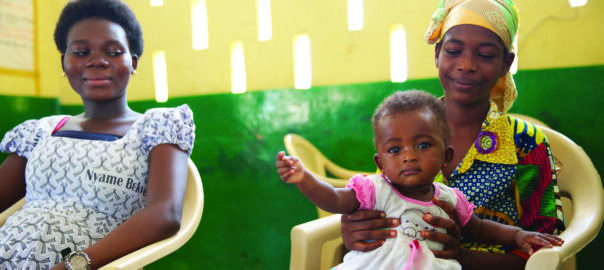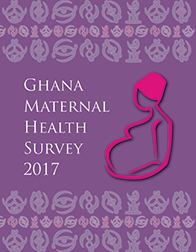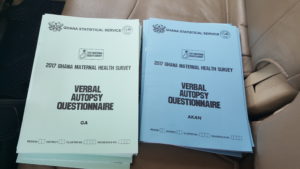From the Field: 2017 Ghana Maternal Health Survey

 When I arrive in the cluster, Joyce, the team supervisor, is assigning households to interviewers Mercy, Cybil, and Naa. They are seated outside a shop—tablets out to receive their assignments over Bluetooth—while in a nearby household, their colleague Vera interviews a respondent as part of the 2017 Ghana Maternal Health Survey (GMHS). After Vera finishes with her interview, they will be moving onto the next cluster. Interviewers often make callbacks, setting up a time that is convenient for the respondent and returning to the household. They will be back here tomorrow.
When I arrive in the cluster, Joyce, the team supervisor, is assigning households to interviewers Mercy, Cybil, and Naa. They are seated outside a shop—tablets out to receive their assignments over Bluetooth—while in a nearby household, their colleague Vera interviews a respondent as part of the 2017 Ghana Maternal Health Survey (GMHS). After Vera finishes with her interview, they will be moving onto the next cluster. Interviewers often make callbacks, setting up a time that is convenient for the respondent and returning to the household. They will be back here tomorrow.
We walk over to the household where Vera is conducting an interview. Vera asks the respondent if it’s okay for me to observe the interview, and she agrees. The respondent is making banku, stirring a steaming pot while she answers the questions. Her young son wanders in and out of the kitchen. When we get to the more sensitive questions in the questionnaire, Vera leans in, speaking softly to put the respondent at ease. At the end of the interview, Vera thanks her, and we head back to the car.
Mercy has the hand-drawn map of the next cluster; she studies it to find the landmarks that will help them identify the boundaries. After a brief car ride, we get out and walk, using the household listing map to make sure we are in the right place. Now I’m tagging along with Naa as she finds her first assigned household. She walks up, introduces herself and the survey, and asks for the head of household.
Naa and I visit three different households over the course of the afternoon. At one, the head of household calls her daughter on her mobile phone to ask her to come home and participate in the survey. The respondent arrives, and I’m in awe. I’m not sure I’d want to go to the trouble of cutting errands short to participate in a survey. It’s even more striking that this respondent is not unique in this regard; The DHS Program would not exist without all the respondents who generously agree to give us their time and attention.
I came to visit the team with Emmanuel, a member of the Ghana Statistical Service’s (GSS) Field Operations and Logistics Unit. As the afternoon comes to an end, he says he needs to head back to the GSS head office. As a man, he cannot observe individual interviews due to the sensitive nature of some of the questions, so he spent most of the afternoon by the car after checking in with Joyce and the interviewers and handing over additional paper questionnaires. The 2017 GMHS includes verbal autopsies – extensive questions about the circumstances of each death of a woman age 12-49 that took place in the past 5 years – and those interviews use paper questionnaires. In contrast, the household and woman’s questionnaires are completed using the tablets. Emmanuel and I head back, but the work continues into the evening for Joyce, Vera, Naa, Mercy, and Cybil.
spent most of the afternoon by the car after checking in with Joyce and the interviewers and handing over additional paper questionnaires. The 2017 GMHS includes verbal autopsies – extensive questions about the circumstances of each death of a woman age 12-49 that took place in the past 5 years – and those interviews use paper questionnaires. In contrast, the household and woman’s questionnaires are completed using the tablets. Emmanuel and I head back, but the work continues into the evening for Joyce, Vera, Naa, Mercy, and Cybil.
To learn more about the 2017 Ghana Maternal Health Survey, watch the Key Findings video below:
Photo Credit: Photo credit: © 2016 Sarah Hoibak VectorWorks, Courtesy of Photoshare

